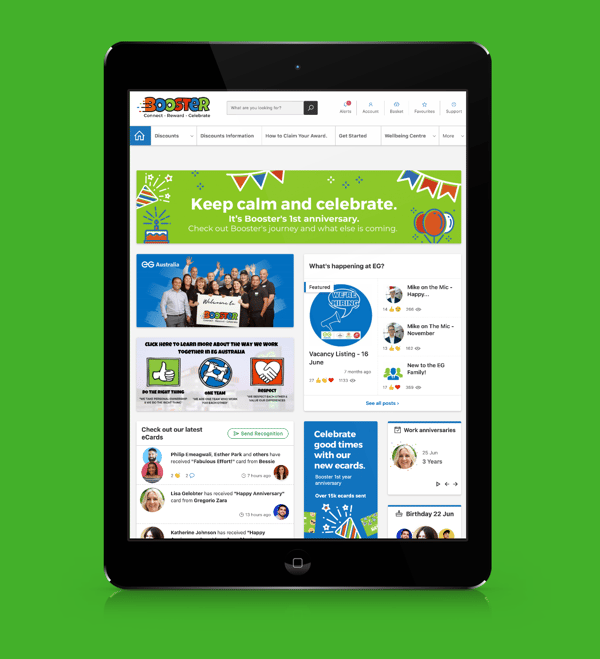For over 20 years I’ve had the pleasure and difficulty of selecting benefit technology partners when working as a rewards leader at numerous global companies. Pleasure, for when I’ve gotten it right, it has truly helped me, my company and my people. Difficulty, for when I’ve gotten it wrong, it’s something I’ve had to pick up the pieces from as it’s caused embarrassment, confusion and a whole array of other emotions and problems.
Luckily, because of those peaks and troughs, I’ve learned a lot of lessons over the years in what it takes to choose the right employee benefits technology partner, whether you’re just starting out or you’re looking to replace your current provider and want to see how the competition stacks up.
Once you’ve determined the ‘why’ behind the need for a benefits provider, whether you’re looking to increase an uptake in a particular benefit, drive better business ROI for your benefits on offer or centralise your benefits in one place, it’s time to dive into the actual selection.
To help narrow down your contenders, it’s important to choose the right criteria to help the process along. This helps you take the emotions and gut reactions out of choosing a partner, and allows you to look at the selection process objectively. I’ve come up with 11 different criteria to help you evaluate. Here is a quick look at each of these 11 points:
| 1. Technology |
| 2. Fees |
| 3. Security |
| 4. Integrations |
| 5. Implementation |
| 6. Customisation and branding |
| 7. Launch |
| 8. Communication |
| 9. Reporting |
| 10. Support |
| 11. Innovation |
1. Technology
 Technology has become a key differentiator in the products being offered by providers. Based on the digital transformation of employee benefits processes and the growing sophistication of enrolment, communication and decision-making support tools, the products and the user experience vary widely from supplier to supplier. Be sure to ask your potential partner about the mobile experience on the platform, log-in options and how employees experience the benefits.
Technology has become a key differentiator in the products being offered by providers. Based on the digital transformation of employee benefits processes and the growing sophistication of enrolment, communication and decision-making support tools, the products and the user experience vary widely from supplier to supplier. Be sure to ask your potential partner about the mobile experience on the platform, log-in options and how employees experience the benefits.
2. Fees
Be crystal clear on the total cost from the get-go. Since you’re going to be working within a budget, you should feel comfortable asking about potential other fees to include in your total cost, such as fixed fees vs. variable fees if, say, your employee headcount changes. You should also ask if the annual fee changes as the technology improves - will you have to pay for additional features?
3. Security
 Especially in an increasingly remote and hybrid working world, security is critically important to the employee experience. Make sure you find a partner who is committed to keeping your employee data safe and secure. Ask them about their approach to security, about their ISO27001 certification and their overall approach to company and employee data ownership.
Especially in an increasingly remote and hybrid working world, security is critically important to the employee experience. Make sure you find a partner who is committed to keeping your employee data safe and secure. Ask them about their approach to security, about their ISO27001 certification and their overall approach to company and employee data ownership.
4. Integrations
How will your tech stack work together and speak to each other? It’s good to understand how data from your new system will share information with your existing HR systems and payroll. Ask about the process for updating employee data, what happens with new starters and leavers and any fees (remember, this is important!) associated with any integrations that are associated with the new platform.
5. Implementation
Once you select your partner, the next part of your journey is actually putting in place that technology and making sure that it’s set up properly. From my experience, this is where the relationship can start unravelling or falling apart, with them not delivering on what they promised during the selection process. Ask your potential partner if there is a dedicated team that will work with you to put in place your unique solution, and see if they can provide references or a sample implementation plan to understand what it will be like working with them as you lead up to launch.
6. Customisation and branding
Like my marketing colleagues, I’ve realised that professional branding is quite important for us HR professionals, too! I love it when a potential provider mocks up their solution to reflect my company’s brand and culture, rather than having a tick-the-box logo in a corner. Ask them how they will help you design a platform that will put a smile on your employees’ faces and how they’ll work with you to bring your employer brand to life.

7. Launch
Ever launched a program only to hear crickets? We all have, haven’t we? The last thing you want is low adoption from your employees, especially after all this hard work has gone into adopting a new platform! In your selection process, dig into how your potential partner will support you during and beyond launch, including who is responsible for what, every step of the way.
8. Communication
After launch, the benefits party doesn’t stop. You’ll need ongoing benefits communication to remind your employees how the benefit works and why it’s important to them. Ask your potential partner what communication tools and techniques they use to drive up awareness and engagement, including best practice tips of the trade to help you along your journey.
9. Reporting
As the expression goes, ‘actions speak louder than words,’ which means that in order to truly understand how your employees are engaging with your new benefits program, it’s important to review their actions through data. Ask your potential partner what their analytics are like for the platform, including what sort of reporting they provide and how they can help educate you on program usage to prove platform ROI.
10. Support
 A key part of any relationship or partnership is how you support one another. In the past, I have liked to see my potential partner as a natural extension of my HR team, and as such they should be there to support my employees with the technology. As HR puts on their agile hats more and more, saving this time so HR can be focussed on strategy and planning, rather than constant firefighting is the key to a successful benefits strategy. Ask your potential partner what hours their support team operates, and how they handle any queries from employees.
A key part of any relationship or partnership is how you support one another. In the past, I have liked to see my potential partner as a natural extension of my HR team, and as such they should be there to support my employees with the technology. As HR puts on their agile hats more and more, saving this time so HR can be focussed on strategy and planning, rather than constant firefighting is the key to a successful benefits strategy. Ask your potential partner what hours their support team operates, and how they handle any queries from employees.
11. Innovation
Last, but certainly not least, is one that I find is often overlooked and that is the benefit technology partner’s approach to innovation. The best partners have plans for developing and scaling their technology and their business, which should align with the changing needs of your own growing workforce and business. Be sure to ask your potential partner where innovation and product sits within their company, how they develop their product road map and how they act on client feedback as part of this map.
Let me end by saying that I know from experience that choosing a benefits technology partner can be a daunting and lengthy process, which is not always easy. But if you invest the time in it upfront you’ll save time and money in the long run, especially since this is a decision that will affect your employees and their experience at work over and over again.
If you have any questions on what to look for, or how Reward Gateway can help you with their benefits technology, then I encourage you to get in touch with them.
 Debra Corey
Debra Corey


